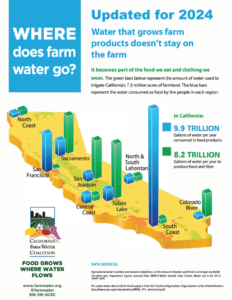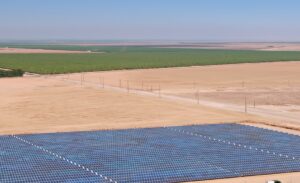May 1, 2020 Letter to Governor Newsom
[gview file=”https://www.farmwater.org/wp-content/uploads/2020/05/Newsom-Ag-Letter-FINAL-May-1-2020.pdf”]
Dear Governor Newsom:
Thank you for your clear and decisive leadership during the COVID-19 pandemic. Your administration’s response to this crisis reflects California’s spirit of community, motivated by the innovation and individualism that makes California stronger, safer and a partner its neighbors and the nation can count on in the fight against COVID-19.
California’s agricultural community embodies that same California spirit. Its farmers responded to COVID-19 by developing new ways to grow the nation’s food supply while protecting workers on the frontlines, keeping the state and nation fed. California’s packing houses and distribution networks safely deliver food to every grocery store in the nation and will continue to meet the demand for abundant, nutritious food for the American people. But as it has for all industries, the COVID-19 crisis has revealed weaknesses in agriculture that must be addressed.
California’s essential workers deserve our highest praise for helping to ensure the nation’s food supply is processed, shipped and stocked on local grocery store shelves everywhere. Their essential work starts with the farmer and rancher, who produce the food and fiber that form the first critical link in the long and essential supply chain that ends on the grocery store shelf. The importance of a resilient food supply was highlighted in the April 24, 2020 letter from 20 members of the Legislature who wrote to Ms. O’Leary and Mr. Steyer asking that food supply be one of the highest priorities for the Task Force on Business and Jobs Recovery as they work to recreate a resilient California economy.
Unlike other essential industries, farmers and ranchers work on nature’s schedule. They must start planning production operations a year in advance. Farmers’ crops must be planted, watered, tended, and harvested based on the seasons. Farmers cannot speed up the growth of lettuce, tomatoes, corn, or oranges. There is no way to “catch-up” if fewer crops are planted this year. What is planted this spring is the food supply this fall and next year.
To ensure next year’s food supply keeps grocery store shelves full it is essential that California’s farmers have all the tools they need to grow the crops they are planting now. Unfortunately, the response to the COVID-19 pandemic has failed to consider the importance of these necessary tools.
A reliable water supply is at the top of this list of tools farmers need to grow the food that will appear in grocery stores later this summer, this fall and next year. Making sure farmers have the water to grow next year’s food supply is as important as making sure grocery store shelves are stocked today.
California’s farmers need access to as much water as the state can provide this year. Unfortunately, the current water year has been dry, with very little rain and limited snowpack in the upper watersheds. This discouraging hydrology is compounded by restrictions on use of groundwater and surface water supplies. Our farmers are left with few options. Unfortunately, the dry hydrology cannot be changed. However, government-imposed restrictions can accommodate farmers’ needs. We urge you to direct state agencies to find creative and balanced means to maximize water supplies for farmers. Where possible, rules that limit farm water supplies should be suspended, modified, or postponed during this critical time.
We reiterate the message conveyed in recent letters from members of the California Congressional delegation and urge your administration to work cooperatively with the federal administration on water management. A cooperative federal-state management scheme should be applied in all those critical watersheds where the federal government has made significant investments, from the Klamath River, to the Bay-Delta and the Colorado River. In this way, we can be assured that state and federal water management coordination is maximizing water supplies while respecting our state’s commitment to the environment. As your administration has recognized in other areas, cooperation between the state and federal administrations is the best way to solve the new and unprecedented challenges we face. Improved state-federal coordination on water issues also will help ensure California’s farmers are efficiently and responsibly using the state’s limited resources to maximize the crops they grow this year.
The undersigned respectfully request that you take the necessary steps to help secure next year’s food supply. We urge you to direct your agencies and departments to find ways to maximize water supplies for farmers this year, until such time that we can normalize the food supply chain from farmer to grocery store shelf.
California also needs to ensure that its farmers continue producing a safe, healthy and abundant food supply into the future. We recommend the following outline for state and federal stimulus efforts to ensure they address the water supply infrastructure that serves California’s farmers and supports the future of our state and national food supply.
Repair and modernize existing water supply and conveyance infrastructure –Climate change, drought and regulation have reduced the water supply once available to farmers. And, when excess water is available, we are missing opportunities to capture and move it simply because our water delivery infrastructure is broken. Subsidence on the state’s major water delivery canals is one example.
Subsidence along segments of the California Aqueduct, Delta-Mendota Canal and Friant-Kern Canal has significantly reduced the amount of water that can get to our farmers. Repairing these three canals will improve water supplies to more than two million acres of agricultural land growing more than 200 different crops that create jobs for more than 131,000 people in the underserved Central Valley. In addition, downstream jobs in other parts of the state associated with these same two million acres employ another 39,000 people. These repair projects are “shovel ready” and construction can begin immediately. They simply require funding support. Local agricultural water agencies are ready to pay their share, but the costs are high and state and federal funding assistance is critically needed. Funding these shovel-ready projects will create jobs, protect our food supply and provide value back to the state for generations.
Accelerate and Support Existing Programs – Researchers at Columbia University recently identified the current dry period facing California as one of the worst in a millennium. This historic drought period is compounded by state-driven institutional actions, including: 1) regulatory programs which seek to reduce groundwater use under the Sustainable Groundwater Management Act (SGMA); 2) a state lawsuit against the U.S. Departments of the Interior and Commerce; and 3) a new permit issued to the State Water Project that reduces water supplies beyond what is necessary to protect species under the Endangered Species Act. We believe California can find ways to turn these negative impacts on farming into positives by: 1) reconsidering the state’s legal action against biological opinions that protect endangered fish; 2) providing funding to build water projects capable of replacing groundwater supplies lost to SGMA; and 3) reconsidering the scientific foundation of the California Department of Fish and Wildlife’s recently issued Incidental Take Permit for the State Water Project (SWP).
The State of California also has an important role to play in the future of farming in the Klamath Basin, which straddles the state border with Oregon. Thanks to the formal request made by you and Oregon Governor Kate Brown, the Department of Interior will provide some welcome emergency drought assistance in 2020 that will benefit wildlife and mitigate many individuals’ conditions. But the situation is very unstable and the community is ridden by uncertainty and anxiety. In the immediate term, California could provide funding for the California portion (Tulelake Irrigation District) of Klamath Project-wide infrastructure assessments for modernization and optimization, as the Oregon Energy Trust has done in the Oregon portions of the Project.
Current water conservation programs are periodically funded through water bonds and can improve agricultural water supplies by making water conservation measures more affordable for farmers. While these types of demand management programs do not make new water available, they can help stretch existing water supplies. Any new infrastructure stimulus bill should include significant funding that incentivizes farmers to further employ state-of-the-art on-farm water conservation technology that would otherwise be unaffordable.
Expand Current Water Supply Infrastructure – California has several options for expanding the capacity of existing water supply infrastructure. These modernization and expansion projects can create jobs in the near term and support rural agricultural economies over the long-term. For example, repair and enlargement of B.F. Sisk Dam and enlargement of Shasta Dam can increase surface water storage without adding new dams on any river. The impacts of these expanded reservoirs can be mitigated in ways that increase protections for endangered species by providing additional cold water and creating more flexible pumping operations that can be modified to protect fish at sensitive times. New storage facilities such as Sites Reservoir and Temperance Flat Reservoir can provide significant new water supplies for rural economies while adding benefits for native species in the Sacramento River, the San Joaquin River, and the Delta.
On the Klamath River, Oregon and California have led an unprecedented effort to remove water infrastructure considered to be outdated (four private hydroelectric dams). A return to an equivalent focus on irrigation infrastructure, groundwater recharge opportunities, strategic storage, and facilities upgrades is equally important, and there are willing partners in the Klamath Project and elsewhere in the Klamath watershed.
Our state stands at a historic crossroads. We believe that the California spirit is evident in the leadership shown by your office and the willingness of Californians to change their way of life for the good of all. We are honored to be part of that effort and proud to produce the food that feeds the state, our nation, and many other countries. Now is the time to take a second step in our response to COVID-19 by protecting the ability of the state’s farmers to keep grocery store shelves stocked with safe, healthy food grown in California. We respectfully request that your administration look for every possible way to increase water supplies to farmers to ensure this year’s crop meets next year’s need.
Sincerely,
| African American Farmers of California |
| Ag Council of California |
| Alameda County Farm Bureau |
| Amador County Farm Bureau |
| American Pistachio Growers |
| Association of California Egg Farmers |
| Bill Diedrich, Diedrich Farms, Firebaugh |
| Bob Amarel, Yuba City |
| Butte County Farm Bureau |
| California Agricultural Irrigation Association |
| California Alfalfa and Forage Association |
| California Apple Commission |
| California Association of Wheat Growers |
| California Bean Shippers Association |
| California Blueberry Commission |
| California Citrus Mutual |
| California Cotton Ginners and Growers Association |
| California Farm Bureau Federation |
| California League of Food Processors |
| California Safflowers Growers |
| California Tomato Growers Association |
| California Warehouse Association |
| California Wild Rice Advisory Board |
| California Women for Agriculture |
| Central Valley Project Water Association |
| Colusa County Farm Bureau |
| Contra Costa County Farm Bureau |
| Del Norte County Farm Bureau |
| Del Puerto Water District |
| El Dorado County Farm Bureau |
| Elephant Butte Irrigation District |
| Family Farm Alliance |
| Family Water Alliance |
| Far West Equipment Dealers Association |
| Fresno County Farm Bureau |
| Glenn County Farm Bureau |
| Joe Del Bosque, Del Bosque Farms, Firebaugh |
| Kern County Farm Bureau |
| Kings County Farm Bureau |
| Klamath Water Users Association |
| Lassen County Farm Bureau |
| Liz Hudson, Hudson Farms, Sanger |
| Madera County Farm Bureau |
| Mark Borba, Borba Farms, Riverdale |
| Mark McKean, Riverdale |
| Merced County Farm Bureau |
| Milk Producers Council |
| Modoc County Farm Bureau |
| Neil Jones Food Company |
| Nevada County Farm Bureau |
| Nisei Farmers League |
| Olive Growers Council of California |
| Orange County Farm Bureau |
| Placer County Farm Bureau |
| Sacramento County Farm Bureau |
| San Diego County Farm Bureau |
| San Joaquin County Farm Bureau |
| San Luis Obispo County Farm Bureau |
| Santa Barbara County Farm Bureau |
| Shasta County Farm Bureau |
| Siskiyou County Farm Bureau |
| Sonoma County Farm Bureau |
| Stan Lester, Lester Farms, Winters |
| Stanislaus Irrigation District |
| Tehama County Farm Bureau |
| Trinity County Farm Bureau |
| Tulare County Farm Bureau |
| Tulelake Irrigation District |
| Wayne Western, Clovis |
| Western Agricultural Processors Association |
| Western Canal Water District |
| Western Growers Association |
| William Bourdeau, Chairman, California Water Alliance |
| Yolo County Farm Bureau |



